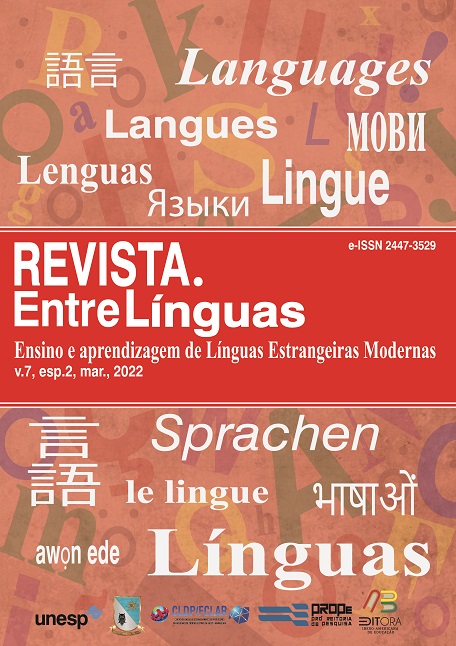Right hemisphere strategy and consideration of lateral profile as an innovative technology for teaching russian as a foreign language to chinese students
DOI:
https://doi.org/10.29051/el.v8iesp.2.17324Keywords:
Cognitive style, Functional asymmetry of the two cerebral hemispheres, Right-hemisphere educational strategy, Russian language, Chinese studentsAbstract
The study is relevant due to a growing scientific interest in the specific features of thinking and cognitive styles of Western and Eastern civilizations, as well as individual ethnic groups that make up these civilizations, at the junction of the humanities and natural sciences. The authors of this article consider the connection between such a psychophysiological phenomenon as the lateral asymmetry of the cerebral hemispheres and the cognitive approach in teaching Russian as a foreign language. According to the cognitive style, Eastern thinking refers to the right hemisphere, while Western thinking inclines to the left hemisphere, which creates a cognitive conflict-academic situation in the learning process. The article addresses the solution of the indicated problems caused by the insufficient consideration of ethno-psycho-physiological features of such students. The paper substantiates the thesis that the Chinese can master knowledge, develop various skills and abilities using the right hemisphere learning strategy with due regard to the theory of functional asymmetry of the cerebral hemispheres.
Downloads
References
AZIMOV, E. G.; SHCHUKIN, A. N. Novyi slovar metodicheskikh terminov i ponyatii (teoriya i praktika obucheniya yazykam) [The new dictionary of methodical term and concepts (the theory and practice of teaching languages)]. Moscow: IKAR, 2009.
BADDELEY, A.; GATHERCOLE, S.; PAPAGNO, C. The phonological loop as a language learning device. Psychological Review, v. 105, n. 1, p. 158-173, 1998.
BIM, I. L. Lichnostno-orientirovannyi podkhod – osnovnaya strategiya obnovleniya shkoly [The personality-oriented approach as the main strategy of renewing school]. Inostrannye yazyki v shkole, n. 2, p.11-15, 2002.
KABARDOV, M. K. Kommunikativnye i kognitivnye sostavlyayushchie yazykovykh sposobnostei: Individualno-tipologicheskii podkhod [Communicative and cognitive components of language skills: individual-based and typological approach]. 2001. Thesis (Doctor Degree in Psychology) – Moscow, 2001.
KHROMOV, S. S.; SHUTOVA, M. N.; NESTEROVA, T. V. Linguodidactic framework of teaching russian intonation to a multinational audience in light of experimental data. Revista EntreLinguas, v. 7, n. 2, 2021. DOI: 10.29051/el.v7iesp.2.15140
KULIKOVA, O. V. Neirodidakticheskii podkhod kak faktor povysheniya kachestva obucheniya inoyazychnomu professionalnomu obshcheniyu [The neuro-didactic approach as a factor of increasing the quality of teaching professional communication in a foreign language]. Vestnik Moskovskogo gosudarstvennogo lingvisticheskogo universiteta, v. 14, n. 700, 2014. Available in: https://cyberleninka.ru/article/n/neyrodidakticheskiy-podhod-kak-faktor-povysheniya-kachestva-obucheniya-inoyazychnomu-professionalnomu-obscheniyu. Access in: 07 Oct. 2021.
NISBETT, R. et al. Kultura i sistemy myshleniya: sravnenie kholisticheskogo i analiticheskogo poznaniya [Culture and thinking systems: the comparison of holistic and analytical cognition]. Psikhologicheskii zhurnal, v. 32, n. 1, p. 55-86, 2011. Available in: https://publications.hse.ru/pubs/share/folder/ck1rjm89ef/70690998.pdf. Access in: 17 Oct. 2021.
PERSIYANOVA, S. G.; LIU, I. Sopostavitelnyi analiz kineticheskogo yazyka u predstavitelei russkoi i kitaiskoi kultur [The comparative analysis of sign languages used by the Chinese and Russians]. Moscow, 2018.
PERSIYANOVA, S. G.; LIU, S. Grammaticheskie trudnosti dlya studentov iz Kitaya pri izuchenii russkogo yazyka [Grammatical difficulties for the Chinese students learning the Russian language]. Moscow, 2017.
POTAPOV, A. S. Psikhologicheskoe obosnovanie sistemy obucheniya s uchetom lateralnoi asimmetrii polusharii golovnogo mozga [The psychological foundation of educational system on the basis of the lateral asymmetry of cerebral hemispheres]. 2002. Thesis (Doctor Degree in Psychology) – Moscow, 2002.
SHANTUROVA, G. A. K voprosu o razvitii emotsionalnogo intellekta vtorichnoi yazykovoi lichnosti pri obuchenii russkomu yazyku kak inostrannomu v kitaiskoi auditorii [On the issue of developing the emotional intelligence of secondary language personality when teaching the Chinese students Russian as a foreign language]. Pedagogicheskii zhurnal, v. 9, n. 1-1, p. 562-567, 2019.
SHANTUROVA, G. A. Neirodidakticheskii podkhod v etnoorientirovannoi modeli obucheniya [The neuro-didactic approach to the ethno-oriented model of education]. RUDN, v. 2, p. 372-375, 2017.
SHUTOVA, M. N. Trudnosti obucheniya kitaiskikh uchashchikhsya russkomu konsonantizmu [The difficulties of teaching the Chinese the Russian consonantism]. In: MEZHDUNARODNOGO KONGRESSA PREPODAVATELEI I RUKOVODITELEI PODGOTOVITELNYKH FAKULTETOV VUZOV RF, 4., 2020. Annals […]. RUDN-GIRYaP, 2020. p. 864-868.
SHUTOVA, M. N.; JIANG, Y. H. Sopostavlenie russkoi intonatsii i kitaiskogo tona [The comparison of the Russian intonation and the Chinese tone]. Moscow: Gos. institut russkogo yazyka im. A.S. Pushkina, 2018.
Published
How to Cite
Issue
Section
License

This work is licensed under a Creative Commons Attribution-NonCommercial-ShareAlike 4.0 International License.
Os manuscritos aceitos e publicados são de propriedade da Revista EntreLínguas. Os artigos publicados e as referências citadas na Revista EntreLínguas são de inteira responsabilidade de seus autores.
Transferência de direitos autorais – autorização para publicação
Caso o artigo submetido seja aprovado para publicação, já fica acordado que o(s) autor(es) autoriza(m) a UNESP a reproduzi-lo e publicá-lo na EntreLínguas, entendendo-se os termos “reprodução” e “publicação” conforme definição respectivamente dos incisos VI e I do artigo 5° da Lei 9610/98. O artigo poderá ser acessado pela rede mundial de computadores (Internet), sendo permitidas, a título gratuito, a consulta e a reprodução de exemplar do artigo para uso próprio de quem a consulta, desde que haja a citação ao texto consultado. Essa autorização de publicação 328 EntreLínguas, Araraquara, v. 1, n .2, p. 323-328, jul./dez. 2015 não tem limitação de tempo, ficando a UNESP responsável pela manutenção da identificação do(s) autor(es) do artigo. Os artigos publicados e as referências citadas na Revista EntreLínguas são de inteira responsabilidade de seus autores.











